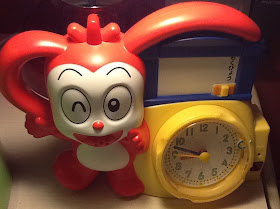
To be totally honest, mealtimes are never easy, regardless of where we are having them. They can be especially tough for kids with sensory issues: the smells, the visual stimuli, the tastes, the auditory information, the tactile input, the need to sit still even though muscles might be jumpy and ready to move. And for Sky, dinner time, which comes at the end of a long day of working hard to keep it together, is the hardest meal of all. So at dinner time, we might see any or all of the following: constant vocalization or humming, inappropriate conversation, total focus on the baby (or any other distraction) and not on his food, aimless wandering (away from the table), crying, anger about what is on his plate or how it is arranged, and an inability to finish his meal because he is too tired (he will literally leave the table and fall asleep on the couch within 30 seconds). Or, if we are lucky, we might see none of these things.
It helps a lot to have food on the table and ready to eat by 5:30. This means I start cooking the minute I walk in the door some days. I cook instead of Ren because I have much better timing. By far the superior cook, Ren creates meals that can hit the table anywhere between 5:30 and 7. Unfortunately, most days, we can't manage such a wide margin of error. On the days when I can control for all conceivable variables, we are able to get through a meal with only one or two minor incidents of inappropriate behavior.
When we go out, though, these incidents can be greatly magnified and occur in quick succession. So I've been trying different things.
Before we exit the car and head into any restaurant, I always ask the same question: "What are the rules of the restaurant?" and the kids dutifully respond: "No running, no yelling, stay in our seats, listen to Mommy and Daddy." They say this with such precision, you'd think we were the Von Trapp family minus the singing. But despite their apparent awareness of what is expected, the moment we step into the restaurant, things often deteriorate quickly. Some days, Sky literally takes laps around the restaurant. Most days, he yells, especially when he is in the bathroom (the echo is appealing). Occasionally, he crashes into things and falls on the floor. Rarely, he discovers a new pain or problem that makes it impossible for him to do anything but cry. These are all understandable (though not acceptable) behaviors given his sensory challenges. Unfortunately, none of them are appropriate in a restaurant, nor to they contribute to a relaxed dining experience for us or for the people around us.
For a long time, then, we avoided eating out altogether. As Sky has made progress with OT and at school, we have tried to slowly but surely help him have successful dining out experiences. That's where the Subway Experiment comes in. We've decided to start small, with Subway, and work our way up.
When it became clear my review of the rules of the restaurant and a pep talk about proper social skills weren't working, I tried mixing it up.
Experiment 1:
Assigning tasks. Sky's job was to help order and Pink P's was to help carry the food to the table. Fail. (Running back and forth to the table, inability to settle down and eat).
Experiment 2:
Practicing silence (this has proven effective in other settings). They weren't supposed to talk while I was ordering and during the first ten minutes of eating. Fail. (Screaming).
Experiment 3:
Dinner with video game to distract Sky from various visual and auditory stimuli. Fail. (No food was consumed).
Experiment 4:
Hands-on guidance. I tried holding their hands, walking them to the table, and helping them get completely situated before going to order. Fail. (This one was close. We made it through the meal and almost out the door before Sky decided to act like a race car and crash into the toy display and numerous chairs on his way back from the bathroom).
For my next experiment, I plan to make a visual schedule that incorporates the rules of the restaurant and all the steps involved in a successful eating-out experience. And, if that doesn't work, I may employ the weighted vest and preemptive brushing.
And while we still haven't had a successful Subway visit, we have had a couple of successful trips to sit-down restaurants (two, to be exact), so now I am wondering if my experiment is patently flawed. Maybe it's the abundance of yellow. Maybe it's the air dryers in the bathrooms. Maybe it's the manufactured bread smell. Maybe it's Subway...















